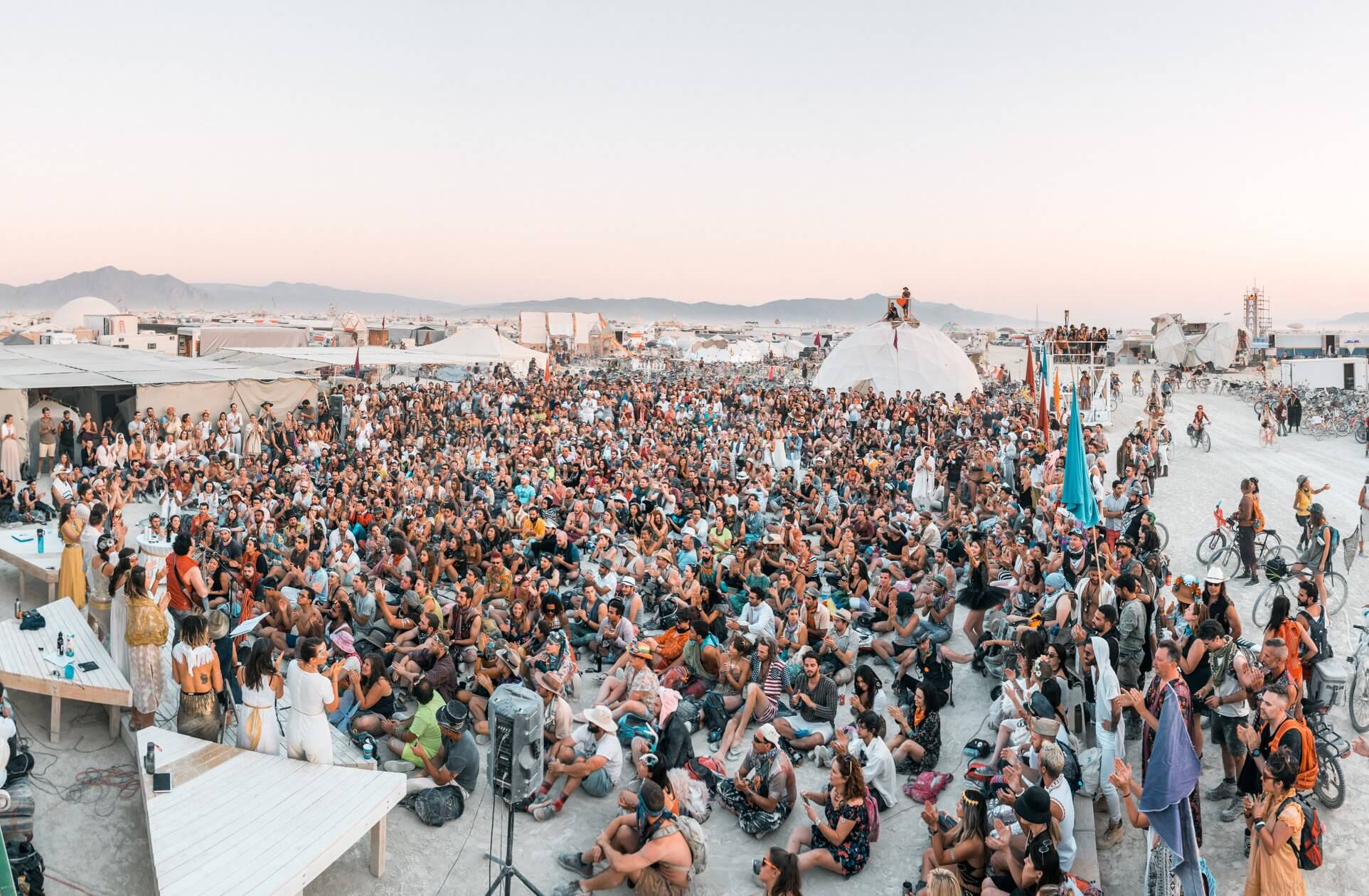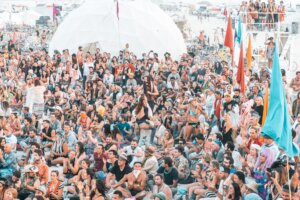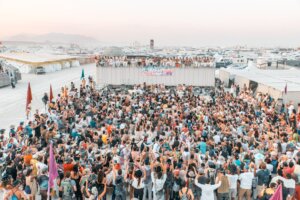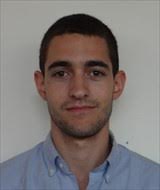Burning Man is back. Get ready for a 1,000-person Shabbat bash in the desert.
‘There’s a lot more to Burning Man than the sort of bacchanalian, Sodom-and-Gomorrah that a lot of people think it is,’ says the co-leader of the Jewish prayer service

Graphic by Angelie Zaslavsky
The Jewish people basically invented the desert bacchanal — what party wasn’t taken to the next level by a Golden Calf? But the desert is also where the descendants of Abraham attained their spiritual pinnacle and received the Ten Commandments — where the Jewish people was formed as a nation. So a Jewish camp at Burning Man — the modern-day apotheosis of both the profane and the spiritual — makes historical and cultural sense, even if it poses practical challenges.
A group of free-spirited Burning Man devotees has been tackling those challenges for going-on 13 years, calling themselves the “Milk + Honey” camp. What started as a small prayer service for a few dozen desert-wandering souls is now a Kabbalat Shabbat for roughly 1,000 of them, followed by a meal. (That’s 120 challahs and 120 bottles of wine, if you’re scoring at home.)
With the weeklong festival of “radical self-expression” in northwest Nevada’s Black Rock Desert returning after a two-year pandemic hiatus, Zvika Krieger — who goes by “Surrender” during the festival — is gearing up for the biggest, hottest and perhaps most spiritually transcendent service yet.
Krieger, 39, whose day job is as spiritual leader at Chochmat HaLev, a renewal congregation in Berkeley, California, co-leads the Kabbalat Shabbat service and Milk + Honey’s 80-person crew. He gave the Forward a preview of what the “Jewish, with an emphasis on the –ish” camp has in store this year on his way to the playa (the 7-square-mile campground is on a dry lake bed). This interview has been edited for length and clarity.

So, how does your camp connect people to the Jewish themes of Burning Man?
The most Jewish thing about Milk+Honey is that we put on a Shabbat prayer service on the one Friday night of the festival. We started 15 years ago with maybe one or two dozen people in a dome that we had built. And over the years, it’s been getting more and more traction to the point where the last time it happened, which is 2019, we had almost 1,000 people show up. We do this prayer service for, like an hour, and then we end the prayer service with this really fun fusion of the ancient and the modern, the sacred and the profane, like Burning Man itself. It’s very musical, there’s moments of meditation, there’s moments of joyous, ecstatic dancing, and there’s moments of connection with other people and sharing Torah wisdom. We also try to weave things in from other religions and other cultures.
And so it’s a really fun, not-your-momma’s prayer service, but people seem to love it. And it’s a real refuge for people. And then right after the service, we feed Shabbat dinner to 1,000 people who show up, with challah and wine and a delicious home-cooked meal. That’s a big novelty on the playa as well — to get a home-cooked meal.
Are there things that you can do in a Burning Man service that you can’t do in a synagogue?
Well, when you have 1,000 people in an open desert space, singing and dancing, it creates a very different vibe than you would have in a synagogue anywhere. And the fact that so much of our tradition happens in the desert, and that entire book of the Torah is called Bamidbar, which means “in the desert,” it feels there’s just a different resonance to the type of worship when you do it in the same sort of ecosystem in which our ancestors did it, in the caldron in which we were formed as a nation.
Burning Man itself is just a very open-hearted space, and people spend the week slowly opening their heart more and more, having deep soulful connections, getting more out of their heads and into their bodies. People are not using their cellphones, they’re away from screens. You arrive at Shabbat with your heart fully open. There’s a lot of tears during the service. There’s a lot of joy and laughter and people are just so ready for that kind of connection in a way that you don’t really get when you’re rushing from your job to a Friday night service — if you go to Friday night service at all.
You know, we talk a lot about “once-a-year Jews” and they’re talking about Jews who only go to services during the High Holidays. And Burning Man is a whole ‘nother type of once-a-year Jews.
What else can you do in Burning Man that you can’t do at a traditional synagogue? You can’t give a drash where you also talk about the Orgy Dome in a traditional synagogue.

I want to ask about the Orgy Dome. There are points in Tanach where mixing something like that with religious practice is deemed an affront. So how do you resolve the tension between the profanity of the overall environment and the sanctity of God?
You know, Judaism is actually a very sex-positive religion. And so much of Jewish mysticism is about sanctifying the profane and finding holiness in our human desires. And so every breath is an opportunity to connect with the divine. And I think that people focus on the sex, drugs and rock ‘n’ roll component of Burning Man — or you might say sex, drugs and house music — but there’s actually a very deep spiritual undercurrent of Burning Man. There are camps that focus on mindfulness and meditation and put on workshops around authentic connection and relating and chanting. There’s a lot more to Burning Man than the sort of bacchanalian, Sodom-and-Gomorrah that a lot of people think it is.
You’re leading a service for possibly 1,000 people of all walks of Jewish life, with a range of Jewish engagement, and probably some not even Jewish. How do you create a service that speaks to all those people, but retains a distinctly Jewish character?
Yeah, well, there’s no siddur because it’s really hard, first of all, to find 1,000 siddurs anywhere, let alone that we can bring out to the desert with us. We don’t do handouts either, because there’s this very big culture at Burning Man of leaving no trace. But really for us, it’s not about looking at the words and getting the words perfectly right. It’s more about connecting to the service with your heart. And so we really try to make a service that is both accessible, but is also authentic in that it’s not just a Disney-fied version of a prayer service, but actually contains this ancient liturgy.
You know, Burning Man is great, and you can experience all sorts of things at Burning Man, but I think people really hunger for deep, authentic spirituality.
So what parts of the liturgy do you hold onto and try to teach, and what modern features do you work in?
We start the night singing nigunim as people are filing in and then we light the Shabbat candles. And then we go through the traditional arc of the Kabbalat Shabbat service — singing prayers like Or Zarua, or Yedid Nefesh, and then we sing Lecha Dodi as a sort of ecstatic peak in the service, dancing and feeling that joy coursing through our bodies.
We do a drash based on the week’s Torah portion, which I’ll be doing this year and I’ve done for the past few years. We follow the service through Barchu and through the Shema, and then we do an Amidah prayer. And a prayer for healing and the mourner’s kaddish. So we get a lot of big key components of the traditional service, and then we weave in new things. We bring in a lot of tunes from contemporary music and from Mizrachi or Eastern backgrounds. And then we do a lot of mashups: last year we layered in George Michael’s “Freedomland,” for example. We bring in secular songs, like when the Black Lives Matter movement was happening and civil rights consciousness was rising, we brought Sam Cooke’s “Change Is Gonna Come” into our service.

With that many people there and so many once-a-year Jews being there, do you become self-conscious at all about being too Jew-y?
I think that people are hungry for authenticity. Especially in progressive circles these days, there are so many people, Jews and non-Jews included, who are turning more towards indigenous wisdom and ceremony, Buddhism, Hinduism — there’s something about the ancientness of that lineage and how that wisdom has persisted that makes it resonate for people. And I think that Judaism has a place right next to those traditions as an ancient source of wisdom that has persevered for thousands of years.
So I think people don’t want that watered-down, SoulCycle version of spirituality. They want something real. And so, yeah, we try to make the service accessible. And we teach people the words and we try to do prayers that don’t have too many words. And we translate things for people and we invite people to not even focus on the words and just to receive and ride the energy of the service. But at the end of the day, I think what people love about it is that it is authentic, and that it is rooted in that traditional liturgy.
Burning Man will coincide this year with the first week of Elul, when we’re beginning to do teshuva. Do you plan on exploring that theme? And is there a natural connection between the themes of Burning Man and the themes of Elul?
I am planning on talking about Elul in my drash, and I’m not going to give a spoiler for what I’m gonna talk about. But what I will say is that the whole concept of teshuva is about returning to yourself, right? The word teshuva means to return, and it’s about returning to your true essence. And I think that at the end of the day, that’s what Burning Man is about. It’s an opportunity where you can shed all of the identities that you take on in order to make it in the world, where you can shed the pretense and shed the sort of image of yourself that you want to put out to others because that’s what you think you need to do in order to be loved or in order to be valued.
Burning Man is a place where nobody talks about their job, or what’s on their resume or what’s on their LinkedIn profile. Most people are not posting selfies or trying to get Facebook likes. It’s just a place where you can really, truly be yourself. And I think it’s a perfect preparation for the month of Elul. And for the theme of teshuva where you can have an opportunity when we put all those distractions aside to remember, who am I really at my core?
What is Milk + Honey doing the other six days of Burning Man?
This year, because it is our 13th year, we are celebrating our b’nai mitzvah. So we’re going to have a “pop mitzvah”: a dance party where we’ll have some unabashedly danceable pop music in honor of our becoming an adult. And then the other big event that we’re doing this year is called Bagels and Cox, which is, you can stop by Milk + Honey on Wednesday morning for bagels and cream cheese and also hot dogs. But before you get your hot dog, you have to get snipped — meaning your hot dog has to get snipped and put in the “tip” jar.






















